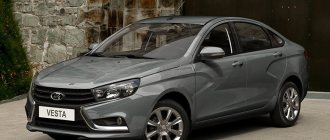Today I want to talk about new foreign cars. When we buy a car ex-showroom, we are always faced with the choice of whether to undergo zero (or intermediate) maintenance or not. Unlike our car brands (VAZ, GAZ, UAZ), many foreign car manufacturers have a warranty inspection interval of 10,000-15,000 kilometers, this is mandatory if you want to remain under warranty. However, the dealer may offer you to undergo the so-called “zero maintenance”, which occurs at 5000 - 7500 kilometers, depending on the manufacturer. What is it anyway, and why is it needed? Does this look like another money grab or not? Let's think...
First, a little definition
Zero or intermediate maintenance (MOT) is an inter-service technical inspection, which is often OPTIONAL, and is done on the first runs of 5000 - 7500 km to remove traces of the engine running in (such as chips from rings and walls).
Should I do it or not?
As I already wrote above, this process was mandatory on our cars, I remember driving my VAZ 2114 for sure! Although now on new VAZs (KALINA, GRANT, X-RAY, VESTA) there are the same intervals as on foreign cars, namely 10 - 15,000 km.
Technologies have stepped forward and now you don’t need to go to 1000 - 3000, or even 5000, and as I already said, an intermediate inspection is NOT mandatory. Manufacturers provide resources so that you can travel the first kilometers without any problems.
The main load falls on the oil filter; it contains chips that are formed from the break-in process. It is advisable to remove it from there or change the filter element itself. After all, if this is not done, then throughput drops
What do they do at zero maintenance?
Many motorists are interested in what they do during this procedure? You know, many people think that this is a trivial change of oil and filter on the engine. BUT THIS IS NOT SO!
- YES the lubricant and filter element are changed in the power unit
- Checking the brake fluid
- Coolant level
- IMPORTANT - the oil in the automatic transmission , because the slightest underfilling or overfilling will wear it out very quickly
- Electrics
- General condition of the suspension
Of course, you shouldn’t think that the car will be thoroughly examined; this is more of a cursory inspection, and the main one is only at the engine.
Decoding of Vesta's maintenance
TO 0 (2500 km):
- Replace the engine oil and oil filter (instructions). It is not necessary to change the oil at TO-0 (more details).
- Make sure there is no extraneous noise when the engine is running.
- Make sure there are no extraneous sounds when engaging and disengaging the clutch (for manual transmission)
- Check the smoothness of gear shifting, make sure there is no extraneous noise when the gearbox is operating
- Make sure there is no extraneous noise in the front wheel drive joints when driving in a straight line and in turns.
- Check that there are no knocks or creaks in the front and rear suspension when driving over uneven surfaces.
- Check wheel alignment angles
- Make sure the electric power steering is working properly
- Check the tightness of the engine mounts
- Make sure there are no engine oil leaks through the seals and oil seals of the engine
- Check the functionality of the engine management system (if there are error codes)
- Check the brake fluid level
- Check that there are no brake fluid leaks, check the condition of the hoses and tubes
- Check and, if necessary, adjust the position of the brake light switch
- Check the operation of the handbrake (tighten)
- Check the effectiveness of the brakes
- Check the operation of the vacuum brake booster
- Check the condition and tension of the generator drive belt
- Make sure that the lighting lamps, light alarm and sound signal are in good condition
- Check the operation of the electric headlight corrector
- Check and, if necessary, adjust headlights
The benefits are obvious to me personally
Firstly, no one is immune from manufacturing defects (even if it’s a cool foreign car, the human factor is always present), if it’s not a significant breakdown (as they say), then God bless it, but if it’s a serious breakdown of the chassis or engine, then it’s not very good anymore. You can detect this breakdown at an early stage.
Secondly, you will have all the vehicle's fluids checked. That is, it is possible to identify a problem with hidden defects, for example, the gasket between the “head” and the block itself is faulty, then the liquid will go either into the cylinders or into the manifold.
Thirdly, at “zero” - they will check your suspension camber, which affects tire wear and handling.
Fourthly, testing of all electrical sensors and wiring in general is carried out.
And the most important thing is to change the oil, for which you will need to pay, and for the oil filter too. But it still needs to be changed - SO I READ. I’ll explain why - a new engine is being run-in at the factory, however, with a run of 3000 - 5000 kilometers, many tiny particles of metal accumulate in it, which remain due to the lack of wear of the metal in the cylinders. And the lubricant that is poured accumulates these particles.
They are not useful at all, and are even very destructive! With a mileage of 3000 - 5000 km, the running-in mode is completely completed and all the “metal dust” is in the oil. You can, of course, wait for the first maintenance, which will occur at 10,000 - 15,000, but it is better to remove this “dust” earlier, just at the “zero maintenance”, at 5000 – 7500 km. This will allow your engine to last as long as possible, of course if you expect to drive this car for a long time.
When and where to undergo the first maintenance on Lada Vesta
According to AvtoVAZ regulations on the Lada Vesta, TO1 must be performed at 15,000 kilometers traveled, or after a year if this distance has not been covered. However, almost all experts recommend undergoing maintenance at 2000 - 5000 km. If you don't do this, dealers may void your warranty. The fact is that new parts are worn in. This leads to increased formation of small metal residues. It is precisely the first kilometers of mileage that are accompanied by this phenomenon, and the shavings walking inside the internal combustion engine and gearbox elements act as an abrasive. This may lead to a quick repair of the part. In addition to oil contamination, at such intermediate maintenance. Service (or maintenance 0) reveals manufacturing defects and, in general, evaluates how the car is running in. Some dealers offer this procedure for free. The cost of work will be from 3 to 5 thousand rubles, depending on the region and service center. But you must remember - if you perform manipulations on the car not from the officials, you risk losing the warranty. Intermediate maintenance is not mandatory; it is not included in the maintenance regulations for the Lada Vesta.
Muscovites, attention!
Editorial Vesta was purchased from the Tekhinkom dealer in Strogino. There we also passed the first maintenance at 15,000 km. There were no complaints about the service, but it was too far away. It was inconvenient to get to home or work without leaving the car. Therefore, in the interval from 15,000 to 45,000 km, I went to VDNKh for maintenance and elimination of a number of problems under warranty.
It would be a good idea to consult the manufacturer’s official website before each trip to the service. I was close to undergoing maintenance on a car under warranty at a service center that had been deprived of its official status just a couple of weeks before the visit. Autocomplex continues to call itself an “official dealer,” but the lada.ru website does not know about it.
It would be a good idea to consult the manufacturer’s official website before each trip to the service. I was close to undergoing maintenance on a car under warranty at a service center that had been deprived of its official status just a couple of weeks before the visit. Autocomplex continues to call itself an “official dealer,” but the lada.ru website does not know about it.
I signed up there for the 45,000 km TO, but when I entered the territory I was embarrassed. The parking lot is practically empty, which has never happened before, the showroom is also empty, and the “Lada” inscription has disappeared from the facade. The AVTOVAZ website confirmed the suspicions: Avtokompleks was excluded from the list of official dealers, although the service center continues to call itself that on the website. And during the recording, the girl operator modestly kept silent about this nuance. Really, it's not good!
The outside temperature sensor on Vesta is poorly located. Once you get stuck in a traffic jam with the air conditioning on, you find yourself in a natural bathhouse. The picture was taken a minute before, at real +30 on the street, +51 will appear on Vesta’s display. With the start of production of station wagons on all Vestas, the location of its attachment has been changed.
The outside temperature sensor on Vesta is poorly located. Once you get stuck in a traffic jam with the air conditioning on, you find yourself in a natural bathhouse. The picture was taken a minute before, at real +30 on the street, +51 will appear on Vesta’s display. With the start of production of station wagons on all Vestas, the location of its attachment has been changed.
The service had to be rescheduled. Thus, our Vesta underwent all three maintenance in different services. I was lucky: a suitable center was found at the same distance from home as the previous one. But things could have turned out to be much more complicated. In Moscow, Lada has 13 dealers left, and 10 of them are located on the Moscow Ring Road, which is not always convenient from the point of view of transport accessibility. The remaining three are also far from the center, halfway from the Moscow Ring Road to the Third Ring Road.
One day I noticed in the mirror that the gas tank flap opened on left turns. Inspection showed that the black bar on the hinge was missing (there is in the photo of the white car and is missing in the photo of our Vesta), which is responsible for pressing the sash. The part is supplied separately, but for its size about the phalanx of the little finger it costs a lot - 290 rubles.
One day I noticed in the mirror that the gas tank flap opened on left turns. Inspection showed that the black bar on the hinge was missing (there is in the photo of the white car and is missing in the photo of our Vesta), which is responsible for pressing the sash. The part is supplied separately, but for its size about the phalanx of the little finger it costs a lot - 290 rubles.
What is zero maintenance
Zero maintenance of Lada Vesta is the intermediate maintenance mentioned above. Zero maintenance is carried out on Lada Vesta with a mileage of up to 3000 km. The following work is being carried out:
1)Diagnostics of an internal combustion engine:
- listening to engine operation;
- checking the tightening torque of engine supports;
- inspect the engine connection points for oil or coolant leaks;
- diagnostics of the Lada internal combustion engine using computer equipment;
- if necessary, replace the lubricant and filter element in the engine;
- checking the serviceability of the timing belt and drive belts of the Lada.
Work for repeated maintenance, etc.
The remaining maintenance is carried out at intervals equal to 15 thousand kilometers, or after 1 year of operation. It depends on which event happens first. Therefore, it is easy to calculate that TO-2 is carried out after 30 thousand km or after a couple of years of driving, and the need for TO-3 arises after 45 thousand km or three years, etc.
Maintenance of a Lada Vesta car, which is carried out second, in addition to the work as part of TO-1, involves the following operations:
- replacing the air filter and spark plugs with serviceable and ready-to-use parts;
- for lubrication of hinges in doors and their restricted areas that cause friction, springs and hinges as part of the fuel tank hatch cover, door lock wells and luggage lids;
- cleaning and lubricating terminals and battery clamps.
List of works during maintenance 1
Maintenance 1 at an official Lada Vesta dealer is scheduled after 15,000 km or a year, if it occurs before these 15 thousand. This is a mandatory procedure under warranty; the mark of completion of Maintenance 1 is entered in the service book. Below is a list of those performed during the first maintenance. maintenance work (here we add a list of maintenance operations 0):
1)Body maintenance:
- cleaning drainage holes in thresholds and doors;
- checking the serviceability of locking devices;
- lubrication of door stops, hinges;
- replacing the Lada cabin filter element;
- assessment of the serviceability of windshield wipers;
- testing heated seats (if equipped);
- testing the rear glass unit defogging device;
- checking the condition of all windows, the functionality of the power windows and the electronic mechanism for turning the side mirrors;
- study of the operation of the air conditioner in different modes.
2) Maintenance of the internal combustion engine and gearbox:
- mandatory replacement of engine oil and oil filter;
- checking the condition of the engine intake and exhaust systems;
- assessment of the tension of the timing belt, drive belts of auxiliary components;
- inspection of the engine cooling system (condition of pipes, radiator, presence of leaks, coolant level in the expansion tank, presence of impurities in it);
- checking the operation of the generator, the generator-battery circuit;
- analysis of the state of the electrolyte in the battery (if it is serviceable);
- inspect fuel lines and hoses for damage and leaks;
- study of the condition of transmission oil and its level.
3)Service of the brake system and steering:
- measuring the amount of play in the Vesta steering rack;
- measuring the residual friction coating of the brake pads (replace if the pads are worn);
- assessment of the integrity of the anthers of the steering tips, racks.
4) Maintenance of the Lada Vesta chassis:
- testing the operation of moving suspension elements;
- checking the condition of chassis parts at the rear and front;
- inspection of CV joint boots, clutch rod, gearbox drive.
CAR SERVICE AUTOMALL BELGORODSKY
LADA Vesta – 1.6 l (106 hp)
In our car service center you can undergo scheduled routine maintenance for your Lada Vesta car while maintaining the dealer’s warranty. All work performed is certified. We carry out maintenance in full accordance with the regulations specified by the manufacturer for Lada Vesta. Below you can find prices for maintenance and spare parts for Lada Vesta.
TO-15 | TO-30 | TO-45 | TO-60 | TO-75 | TO-90 | |
Mileage [km]: | 15 000 | 30 000 | 45 000 | 60 000 | 75 000 | 90 000 |
TOTAL COST | 4220 | 6063 | 4220 | 6063 | 4220 | 11083 |
Job title: | ||||||
Engine oil | + | + | + | + | + | + |
Oil filter | + | + | + | + | + | + |
Cabin heater filter element | + | + | + | + | + | + |
working fluids, air conditioning system refrigerant – top up (refill) if necessary* | + | + | + | + | + | + |
front brake pads - replacement if necessary* | + | + | + | + | + | + |
presence of cracks and corrosion of the body, peeling of mastic from the bottom and wheel arches | + | + | + | + | + | + |
operation of door and hood locks | + | + | + | + | + | + |
The condition of the front and rear suspension elements, their rubber and rubber-metal hinges, bushings and cushions, the condition of the steering rod joints and their protective caps, the steering rod joints and their protective caps; protective covers of the steering mechanism, wheel drives, ball pins, condition of the cable ends of the gear shift control drive and their protective covers | + | + | + | + | + | + |
Total play in steering | + | + | + | + | + | + |
Tightness of cooling systems, power supply, hydraulic drive of brakes and clutch; condition of hoses, tubes and connections | + | + | + | + | + | + |
Tightness of seals of components and assemblies | + | + | + | + | + | + |
Brake fluid level in the hydraulic brake reservoir | + | + | + | + | + | + |
Coolant level; | + | + | + | + | + | + |
Condition and tension of the auxiliary drive belt (generator) | + | + | + | + | + | + |
Condition of wires, reliability of connections and fastening clamps | + | + | + | + | + | + |
Operation of the generator, lighting, light and sound alarms, electrical equipment and electronic systems according to the indicators of the instrument cluster and other indicators on the instrument panel | + | + | + | + | + | + |
Absence of non-functional noise and knocking in the engine, transmission components and assemblies | + | + | + | + | + | + |
Performance of the service and parking brake systems | + | + | + | + | + | + |
Condition of rims and tires, air pressure in tires | + | + | + | + | + | + |
Condition of front brake pads and brake discs | + | + | + | + | + | + |
Presence and correct location of warning labels in the vehicle interior | + | + | + | + | + | + |
Battery condition | + | + | + | + | + | + |
Compliance with established standards for the boundaries of light beams of headlights | + | + | + | + | + | + |
Power steering performance | + | + | + | + | + | + |
The functionality of the vehicle's electronic systems using instrument panel indicators and the absence of fault codes in the controller's memory | + | + | + | + | + | + |
Engine air filter | + | + | + | |||
Spark plug | + | + | + | |||
Rear brake pads - replacement if necessary* | + | + | + | + | + | |
Brake fluid | + | |||||
Coolant | + | |||||
Accessory Drive Belt and Tensioner Pulley | + | |||||
total COST OF WORK | 1600 | 2000 | 1600 | 2000 | 1600 | 5000 |
* spare parts, working fluids, refrigerant and replacement work (topping up/refilling) are paid additionally by the consumer | ||||||
Cost of spare parts | 2620 | 4063 | 2620 | 4063 | 2620 | 6083 |
LADA Vesta – 1.8 l (122 hp)
TO-15 | TO-30 | TO-45 | TO-60 | TO-75 | TO-90 | |
Mileage [km]: | 15 000 | 30 000 | 45 000 | 60 000 | 75 000 | 90 000 |
TOTAL COST | 5500 | 6250 | 5500 | 6250 | 5500 | 11000 |
Job title: | ||||||
Engine oil | + | + | + | + | + | + |
Oil filter | + | + | + | + | + | + |
Cabin heater filter element | + | + | + | + | + | + |
working fluids, air conditioning system refrigerant – top up (refill) if necessary* | + | + | + | + | + | + |
front brake pads - replacement if necessary* | + | + | + | + | + | + |
presence of cracks and corrosion of the body, peeling of mastic from the bottom and wheel arches | + | + | + | + | + | + |
operation of door and hood locks | + | + | + | + | + | + |
The condition of the front and rear suspension elements, their rubber and rubber-metal hinges, bushings and cushions, the condition of the steering rod joints and their protective caps, the steering rod joints and their protective caps; protective covers of the steering mechanism, wheel drives, ball pins, condition of the cable ends of the gear shift control drive and their protective covers | + | + | + | + | + | + |
Total play in steering | + | + | + | + | + | + |
Tightness of cooling systems, power supply, hydraulic drive of brakes and clutch; condition of hoses, tubes and connections | + | + | + | + | + | + |
Tightness of seals of components and assemblies | + | + | + | + | + | + |
Brake fluid level in the hydraulic brake reservoir | + | + | + | + | + | + |
Coolant level; | + | + | + | + | + | + |
Condition and tension of the auxiliary drive belt (generator) | + | + | + | + | + | + |
Condition of wires, reliability of connections and fastening clamps | + | + | + | + | + | + |
Operation of the generator, lighting, light and sound alarms, electrical equipment and electronic systems according to the indicators of the instrument cluster and other indicators on the instrument panel | + | + | + | + | + | + |
Absence of non-functional noise and knocking in the engine, transmission components and assemblies | + | + | + | + | + | + |
Performance of the service and parking brake systems | + | + | + | + | + | + |
Condition of rims and tires, air pressure in tires | + | + | + | + | + | + |
Condition of front brake pads and brake discs | + | + | + | + | + | + |
Presence and correct location of warning labels in the vehicle interior | + | + | + | + | + | + |
Battery condition | + | + | + | + | + | + |
Compliance with established standards for the boundaries of light beams of headlights | + | + | + | + | + | + |
Power steering performance | + | + | + | + | + | + |
The functionality of the vehicle's electronic systems using instrument panel indicators and the absence of fault codes in the controller's memory | + | + | + | + | + | + |
Engine air filter | + | + | + | |||
Spark plug | + | + | + | |||
Rear brake pads - replacement if necessary* | + | + | + | + | + | |
Brake fluid | + | |||||
Coolant | + | |||||
Accessory Drive Belt and Tensioner Pulley | + | |||||
total COST OF WORK | 1600 | 2000 | 1600 | 2000 | 1600 | 5000 |
* spare parts, working fluids, refrigerant and replacement work (topping up/refilling) are paid additionally by the consumer | ||||||
Cost of spare parts | 2620 | 4063 | 2620 | 4063 | 2620 | 6083 |
* Price information contained on this Site is for informational purposes only. The prices indicated are the maximum resale prices (unless otherwise expressly stated in the relevant section of the Site) and may differ from actual prices. The purchase of any service and spare part is carried out in accordance with the terms of the individual sales contract. The information presented on the Site does not mean that these Products are available for sale. For more information, please contact the manager by phone 37-60-60, 37-55-99.*
**The information presented on the site regarding recommended retail prices, specifications, standards and technical characteristics is for informational purposes only and under no circumstances constitutes a public offer as defined by the provisions of Article 437 (2) of the Civil Code of the Russian Federation. Pads and brake discs are replaced according to wear. Find out the required volume of brake fluid at the AutoTechCENTER. Depending on the engine type, different additives may be used.
List of works during maintenance 2
Every 30,000 km or two years of operation, it is necessary to undergo the Maintenance 2 procedure. The second and subsequent services of the Lada Vesta are mandatory and are carried out every 15 thousand mileage with a report entered in the book. They always include changing the oil, air, cabin and oil filters, and inspecting the condition of Vesta parts. Maintenance No. 2 consists of TO0, TO1 with the addition of a list of works. Therefore, the cost of manipulation is higher - from 6 to 8 thousand rubles.
Maintenance procedures 2, except those mentioned earlier:
- replacing the air filter;
- lubricating battery contacts and cleaning them;
- replacing the cabin filter;
- lubrication of door locks;
- replacing spark plugs;
- checking the wear of tires and wheel rims on the Lada;
- wheel balancing.
Replacements according to service life
The alternator belt is changed quite rarely. It usually needs to be replaced after 180 thousand km. mileage Sometimes, during intensive use, it is changed earlier. Depending on the type of motor, it will cost 2900-4000 rubles.
The chain is not designed for replacement, but is used up to 250 thousand km. When such values are reached, it is worth updating.
A fuel filter is also installed for long-term operation. The need for replacement may arise no earlier than approaching 180 thousand.
Subsequent maintenance
After the sixth technical maintenance cycle of preventive maintenance begins anew. The only difference is that at the next 90,000 km (namely 180,000 mileage from the release of Vesta), the replacement of the timing belt with all accompanying rollers is regulated. Please note that it is possible to replace the belt ahead of schedule if signs of wear are detected. The fuel filter is changed only together with the pump at the same 180,000 km in case of failure. The most common maintenance problems that occur!
At the initial stages of break-in, owners may encounter the following malfunctions:
- minor damage to the glass (it is important to undergo maintenance 0, this is often caused by defective windshield wipers);
- burnout of the resonator, its corrosion;
- wear of the engine cooling system hoses;
- rapid failure of glass heaters;
- wear of the rubber parts of the rear anti-roll bars of the Lada;
- malfunction of the lower ball joints;
- multimedia malfunctions.
These are the main “faults” of all modifications of Lada Vesta. We advise you to pay attention to them already at the first service.
Planned maintenance work should not be neglected. And the loss of warranty is not the most important thing. After all, timely maintenance is the prevention of urgent repairs, extending the service life of Lada Vesta components and a guarantee of confidence on the road.
For all Lada cars, the service interval is 15,000 km (the only exception is the Niva 4x4, which must undergo regular maintenance every 10,000 km), or once a year (whichever comes first). Many owners are familiar with the concept of “zero maintenance”, which, as a rule, involves replacing the engine oil and oil filter after the first 3,000 km. Let's figure out whether it is necessary to undergo TO-0 or not.
Until mid-2013, owners of Lada Granta and Lada Kalina cars had to undergo zero maintenance after 3,000 km. Later, the company changed the requirements, which it described in regulation No. 58-13.
Zero maintenance (2,000 – 3,000 km) must be carried out:
- Lada Granta and Kalina (and now the budget Priora) with 8 valve engines (list of works - valve adjustment).
- Niva 4x4 (list of works - changing transmission oil in the gearbox, rear and front axles, transfer case)
It turns out that the first engine oil change on all Lada cars should be done at a mileage of 14,500..15,500 km (for Niva 4x4 in the interval of 9,500..10,500 km).
Maintenance regulations for Lada Vesta
LADA Vesta began production at the AvtoVAZ plant in November 2015. Equipped with motors: 11189, 21129 and HR16DE-H4M. The latter is an imported engine produced by the Renault-Nissan alliance. The most common engine is 1.6 liter. 21129 is the well-known VAZ engine 21127 with some modernization. It is this that is taken as the basis for this routine maintenance.
The frequency of replacement of Lada Vesta consumables is 15,000 km . In severe operating conditions, it is useful to reduce the interval to 10,000 km and even more - to 7,500. There will definitely be no harm from this, except for your wallet.
First of all, reducing the replacement interval concerns the oil and oil filter. The air and cabin filters should be checked and at least blown out, and if they are heavily soiled, they must be replaced.
Severe operating conditions include:
- driving in a large city with frequent trips over short distances;
- long-term movement at low speed;
- moving through dusty areas;
- transporting a trailer or driving a heavily loaded vehicle.
Below we will describe a map of the routine maintenance of the Lada Vesta, as well as the catalog numbers of the necessary consumables and their average prices (indicated for Moscow and the region) that will be needed for work. The maintenance diagram looks like this:
List of works TO-1 (15,000 km)
| List of works | Lada XRAY | Lada Vesta | Lada Largus | Lada Granta | Lada Kalina | Lada Priora | Niva 4x4 |
| Changing the engine oil | Yes | Yes | Yes | Yes | Yes | Yes | Yes |
| Replacing the oil filter | Yes | Yes | Yes | Yes | Yes | Yes | Yes |
| Replacing the cabin air filter | Yes | No | No | Yes | Yes | Yes | No |
| Replacing the engine air filter | Yes | No | Yes | No | No | No | No |
You can learn more about the materials required for passing a technical inspection, as well as the approximate cost of maintenance, on the official page.
A complete list of works for all maintenance is also specified in the regulations:
At what mileage do you change engine oil for the first time? Is it worth immediately changing the oil in the engine that comes from the factory with your own? Let us remind you that the first 2000 km of mileage are considered the period of running in the car, when when driving the car it is not recommended to exceed the speed of more than 110 km/h and the engine speed of 3500 rpm.
First maintenance on Vesta
When purchasing a new Lada Vesta car, the number of thousands of kilometers required for sufficient maintenance (TO-1) may be unknown. But, following the same regulations, this measure is resorted to after 15 thousand kilometers or after 1 year of movement, relying on an earlier event.
During maintenance, the oil necessary for engine operation and filters for oil and heating devices in the cabin are replaced. If there is not enough fluid, it is filled in, followed by replacing the brake pads at the front.
Spare parts for Lad Vesta cars, fluids and other work, including refueling, are subject to additional payment.
During initial maintenance, the following components are diagnosed and function assessed:
- car suspensions;
- control via steering wheel;
- braking and gearbox systems;
- operation of electrical equipment with assessment of the condition of wiring and connections;
- safety of hoses, pipelines and connecting systems;
- degree of reliability of chassis body fastening;
- condition of installed wheels and tires with pressure level;
- extraneous engine sounds in transmission units;
- car battery;
- body surface to cracks and corrosion;
- correct operation of the locks.
Malfunctions identified during the inspection must be corrected by the service. According to the maintenance regulations, the drainage holes of doors and thresholds are cleaned. Finally, the owner is given advice on how to properly maintain the car.
If you follow the rules, at the end of TO-1 it is mandatory to put a corresponding mark in the book with data about the service.
Maintenance cost
The cost of the service offered by official category dealers is 5.9 thousand rubles. in Moscow and St. Petersburg. In the regions, average prices fluctuate at 5.2 thousand rubles. In general, prices vary from dealer to dealer.
The cost of maintenance for other cars, not like the Lada Vesta, will be more expensive. The cost of initial maintenance for cars of the Rio, Polo and Solaris brands is 7.5 thousand rubles. For Logan cars, the service is estimated at 10 thousand rubles.











